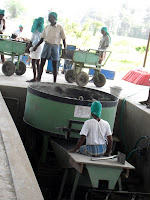The Eagle has Landed

We arrive at Kuthur, the headquarters of LAFTI, around 11:00. It looks the same – the same pink Kremlin of a building that serves as secretariat, sleeping rooms, dining room when needed, public meeting space, and lounge all interchangeable and some simultaneously.
 But wait! Right out in front of the building is an open-sided shed, perhaps 70’ x 35’. This is where the first brickmaking machine is established, inset into the ground, as well as 11 or 12 completed biosand water filters, ready for use. I see a large group of workers there, with green cloths tied into turbans, and the sounds of industry.
But wait! Right out in front of the building is an open-sided shed, perhaps 70’ x 35’. This is where the first brickmaking machine is established, inset into the ground, as well as 11 or 12 completed biosand water filters, ready for use. I see a large group of workers there, with green cloths tied into turbans, and the sounds of industry.I get out of the car, and we are met by all my old friends – Veerasami, Vengopu, Muniyan the accountant, Thamba the publicist, there are so many others. After a round of hugs, Veerasami puts a green cloth around my shoulders. I ask him to tie it into a headcloth for me, and I run to brickmaking machine. This apparently is the first hour that the bricks are being made. The men of village of Karunganni (don’t ask me to pronounce it – it is a lot more complex than in looks here), having leveled their own homes, have come to make bricks – several days early. So the machine is oiled up, everything works properly, the big drum mixes fly-ash, sand, cement, and gypsum, the mixture comes up the conveyor belt, and is pressed into bricks, two at a time.
 It took less than half an hour for the villagers to get the hang of it, and they are proud to be making their own homes, from the foundations and bricks on up! I make a few myself, push some loads of fly-ash, then run into the headquarters, change into a pair of shorts and tee-shirt and, still with my headcloth on, return to the brickmaking for little bit. This is, after all, a cameo appearance; the machine has been called “David’s machine” (even though ultimately I did not raise the funds for it, which were contributed by the Oil and Natural Gas Corporation), and so I have to get my picture taken numerous times.
It took less than half an hour for the villagers to get the hang of it, and they are proud to be making their own homes, from the foundations and bricks on up! I make a few myself, push some loads of fly-ash, then run into the headquarters, change into a pair of shorts and tee-shirt and, still with my headcloth on, return to the brickmaking for little bit. This is, after all, a cameo appearance; the machine has been called “David’s machine” (even though ultimately I did not raise the funds for it, which were contributed by the Oil and Natural Gas Corporation), and so I have to get my picture taken numerous times.Kuthur is still beset by power cuts, at least two hours a day, and at least seven on Sunday, sometimes more. The office staff sits around uncomfortably; worse, the power outage means we can’t make bricks! So I talk with Krishnammal, and she says, Brilliant idea!”
I gather the village brickmakers together. “Did you have a good lunch?” I ask (all being translated into Tamil.)
“Oh, yes,” they reply, and it is likely that lunch provided by LAFTI is better than these poor men would have had at home.
“Good,” I say, “We are going to turn every power outage into an opportunity. Power outages will be the signal that we are to go dig up and work on putting in new vegetable gardens (now called, “David’s gardens”, I feel like I am in my own memorial site) so that the next groups of workers can have good meals as well.”
They are very pleased; these are people of the land, and this is something they understand quite well. So the rest of my smuggled vegetable seeds will be used here. By the next afternoon, the first garden is entirely dug up.
“This soil is not good for vegetables, only for rice” says Arul, newly deputed from Rajagopal’s staff to work for LAFTI, and who has three years of training in organic agriculture.
“Oh yes it is,” says Swami David from New York City, who is known to have a white thumb – everything he plants turns to ash.
I have two secrets. First, I happen to know that this particular piece of ground once had a wonderful garden of Italian vegetables, planted with seeds that Krishnammal had smuggled back from Italy.
But there is a second, more important secret that will be revealed in a future installment.
I immediately take a great liking to Arul. He will be a terrific asset to LAFTI if given the opportunity. An expert in organic agriculture will serve LAFTI beneficiaries well, and he also seems to have good computer skills. Most importantly, he seems ready to jump at every opportunity. I ask Krishnammal whether we can take him along on our various jaunts, to give him a greater sense of what this is all about. I know, however, that he probably understands much already, as he grew up in a major prawn farm area 40 kilometers to the south, scene of one of LAFTI’s great struggles.
Later, I sit down for lunch with Veerasami, Krishnammal, and Arul. Arul is quite taken aback – it is not common for a new worker to be invited to lunch with the highest echelon of the staff on the first day. But I do finally convince him to sit down, though he will only do so on the ground, next to Veerasami. This is a constant struggle for me, as I seem to have too much status to get some of the workers to sit in a chair next to me for fruitful conversations, so I usually end sitting on the ground with them, so they can’t escape.
“I want to propose a project for Arul, part of his employment,” I suggest. “He grew up among the prawn farms. He has substantial experience in organic agriculture. And he comes to us well-regarded by Rajagopal.”
They all nod; I hope I haven’t embarrassed Arul.
“Frankly, I don’t trust that the people at the Swaminathan Research Foundation will make good on their promise. I hope I am wrong, but I don’t think it can be counted upon. In addition, even if they do, they will need a liaison from LAFTI. I suggest we give this responsibility to Arul.”
“Furthermore, we already know (because they told us) that there is a technology – the use of a particular algae to change the salinity of the soil. So maybe, with the proper research, we might be able to do this without the scientists.”
It is agreed. Later, Arul tells me he has a friend who works at the Foundation’s research office in Pompuhar, so he can probably get help in researching what needs to be done. I commend his audaciousness, give him my Friends of LAFTI card, and tell him I will be checking in.
We’ll see. Everything is possible.
I wake up the next morning at 6:00 A.M. and come outside to greet the dawn. Not 35 feet away from me, on the pile of fly-ash, an Indian eagle has landed. Or to be specific, a Brahmany Kite, a magnificent bird with reddish brown and golden wings and white breast and head.
I choose to interpret this is as a good omen. (Of course, maybe he looks at me the same way, as a potential food source!)


1 Comments:
The way you explained is interesting. Yes, a fly ash brick provides better output with less power supplies and practically no breakage during transport and use.
Post a Comment
<< Home